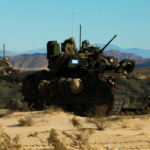
Less than two weeks into its official activation, the Army’s Futures Command (AFC) has two new confirmed leaders and plans to establish a technology incubator aimed at bringing in more non-traditional industry partners and getting capabilities out faster, senior officials said Wednesday. Army Under Secretary Ryan McCarthy and Gen. John “Mike” Murray, the leader of AFC, told attendees at a Defense News conference they imagine the new “Shark Tank”-style incubator will look “a sea of laptops” and provide smaller start-up…

 By
By 











